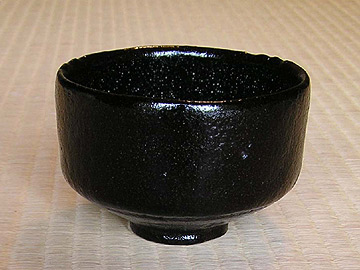|
||
 |
||
Popular belief holds that during the late 1570s Sen Rikyuu 千利休 (1522-91) was so impressed by the roof tiles of the artisan Choujirou 長次郎 (1516-92) that he asked Choujirou to create teabowls emphasizing a quiet, simple and unassuming aesthetic. The patronage of Rikyuu allowed Choujirou to establish a workshop. More than one person likely worked on a specific teabowl although the production process of Choujirou, his workshop, and followers lends a sculptured aesthetic to their teabowls. Rikyuu is associated with black raku bowls kuroraku 黒楽 as they best express his aesthetic of wabicha わび茶. Red raku bowls akaraku 赤楽 are more common from the early 17c. The second generation raku potter Joukei 常慶 continued Choujirou's work, but the line was solidified by the third generation master Dounyuu 道入 (1599-1656, also called Nonkou ノンコウ), patronized by Sen Soutan 千宗旦 (1578-1658) and Honnami Kouetsu 本阿弥光悦 (1558-1637). He originated a highly viscous glaze makugusuri 膜釉 for which later raku tea bowls are famous. The raku making family trace fourteen generations in direct succession from Choujirou at the hongama 本窯 (main kiln), but there are many other potters trained in the raku tradition.
 |
(C)2001 Japanese Architecture and Art Net Users System. No reproduction or republication without written permission.
掲載のテキスト・写真・イラストなど、全てのコンテンツの無断複製・転載を禁じます。

